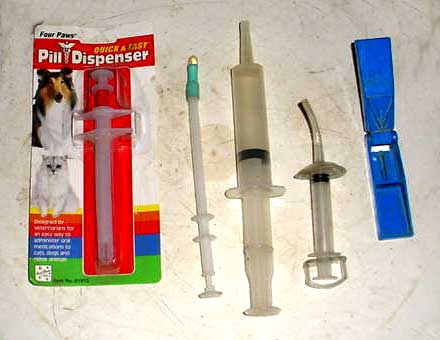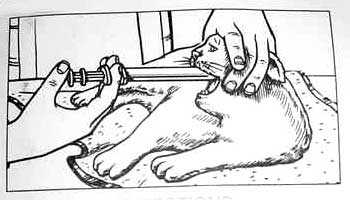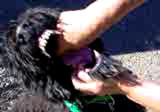
How to Give a Pill to a Dog(giving pills and liquid medications) |
There are a number of ways to get a dog to take a pill (and most of these also apply to cats). The two main methods are hiding the pill inside food or mechanically stuffing the pill down the throat. I include short movie clips of both methods of stuffing a pill down a dog's throat. (I will be talking about dogs in this article, but with slight modification most of this also applies to cats. )
| SITE INDEX | BOUVIER | RESCUE | DOG CARE |
| PUPPY REARING | TRAINING | PROBLEMS | WORKING DOGS |
| BOOKS | VERSE | IMAGES | MISCELLANEOUS |
There are many methods of giving a pill to a dog or cat.
The two main methods are
Warning : be sure it's the right pill !Before you give any medication, you must be sure it is the RIGHT medication. And of course all of this applies to human meds as well. |
I also love to lay out a week's pills in one of those organizer boxes. Some organizers give separate compartments for morning and evening and some give you 4 compartments per day. Use some lable (masking tape works well) to put the pet's name on the box if you have more than one pet. The boxes are especially valuable if there's more than one person in the home , thus you both need to know if the other has or has not given a scheduled dose. If it's still in the box, obviously it has not yet been given. Also very helpful for complex dose schedules with more than one drug. Also very helpful if your own memory is imperfect (as mine certainly is imperfect).. I really adore organizer boxes !
Dr Sophia Yin, DVM in her excellent text for veterinarians, "Low Stress Handling, Restraint, and Behavior Modification for Dogs and Cats", discusses how owners can teach their pets to accept many common medical procedures and restraints. Indeed she shows step by step methods for tesching the pet to relax and even enjoy such procedures. One of the most common procedures is accepting a pill or liquid medication.
Basically you practice giving pills by offering the dog a pill sized object that is actually tasty. You could practice the procedure of placing a pill into the dog's mouth by using a green pea as your pill (or any other pill sized piece of food that your dog likes). You could practice giving a pill hidden in a glob of food by simply giving the glob of food with nothing inside it or with a pea inside it. Your pill hider food could be a chunk of hot dog (pill hidden in a slit in the chunk). You can practice giving liquid medication by using some very tasty liquid such as chicken broth.
Unless your dog has little appetite, you can usually give a pill simply by hiding it inside a glob of something very tasty. I generally use either soft cheese, such as the product CheezeWhiz, or I use peanut butter. Peanut butter has the advantage of being sticky enough that it's hard to spit out. Chunky peanut butter has enough little chunks that feel similar to the hidden pill that it's harder for those dogs who might want to sort out the pill and spit it out to do so. (Peanut butter has the disadvantage for me that I like it myself and will give myself a spoonful from time to time. Peanut butter might be totally prohibited in a household in which some member has a severe allergy to peanut products.) Lately I have also discovered that cream cheese (a product I would never normally buy because I don't want to eat it myself) is still one more good pill hider. (For cats, cheese or peanut butter can work, but you could also use anchovy paste.) Of course canned dog food (or cat food) can also work, but it's a bit messier for your hands. A piece of hot dog with a slit cut into it to hold the pill can also work, especially for dogs who will just gulp a hot dog piece down. Finally, there's a product on the market called Pill Pockets, which you can probably find at a store such as PetCo or PetsMart ; a bit more expensive but if it works better for you than other pill hiders, it's well worth it.
UPDATE : re peanut butter, and re any sticky food
Xylitol is deadly dangerous to dogs !!!
I no longer recommend peanut butter because some peanut butter now contains Xylitol. Xylitol causes dog's blood sugar to drop dramatically and this can put the dog into coma or KILL the dog. Worse yet, the Xylitol is not always listed in the ingredients section of the product lable. So it's best to not take the risk. I don't know if Xylitol is dangerous to cats or not.
Still another possibility would be to put the pill inside a glob of baby food. For cats, a meat baby food. Again, I'd wonder if there's any risk of the product containing Xylitol.
Keeping sticky food off your fingers
For cheese or any other sticky food, anything you don't want on your fingers, use a knife or spoon or any implement to transfer a glob of the food onto a small piece of bread or a cracker or a piece of tortilla (corn or flour), place the pill or pills onto the glob of sticky food, and fold over the bread or tortilla or possibly add second cracker on top, then offer it to your dog. I started doing this with a particular pill that one dog wouldn't accept when offered inside a Pill Pocket, and I happen usually to have tortillas in the fridge and soft goopy cheese spread. Worked great, so now I'm doing it for all pills for all my dogs.
Now one thing you have to consider before hiding a pill inside food is that there are some medications that work best when given on empty stomach, given without food and at some time interval before and after any food is eaten. Some others work best when given with food , and for some it does not matter. (And some human meds should not be taken with milk or milk products ; I've no idea if this could apply to any vet meds but it make sense to think it probably does.) Always ask your vet for specific instructions on this aspect, if she has not already instructed you. Also sometimes two or more medications must be given at different times, ie with some time interval between them. If you forgot to ask at the clinic, pick up the phone. No vet is going to object to a client wanting to be careful. (Ideally the vet gave you written instructions, but you might still have a question.)
If your dog has any food allergies, of course you have to avoid using any pill hider that you do not know to be allergy-safe for him. Likewise if your dog is in the middle of an "elimination diet" food allergy test, you can't use any other food ingredients.
By the way there's a medicine, Clavamox, that comes wrapped in foil. The foil protects the pill from light and moisture. Do NOT unwrap the pill until just when you are about to give it to the pet. (And if you have to give a half-pill, re-close the foil to enclose the second half until time to give it.) Vets don't always remember to tell you this, and not everyone reads any printed directions. This is an excellent antibiotic for quite a few types of use, and it's well worth the slight nuisance.
There are two ways of manually putting a pill far enough back into the dog's mouth that he will swallow it. Both begin by opening his mouth with one of your hands. The second step is inserting the pill either with your other hand or with a pill insertion device.
I tend to prefer using my fingers as I want to be sure of placing the pill and I don't want to hurt the dog with a mis-judged poke from the inserter device. But some dogs might be chewing and cause you to worry about injury to your fingers.
Below is a picture of some tools used in giving medications. From left to right : the two left-most are pill inserters, with the second from left holding a capsule of vitamin E ; the middle two are a veterinary catheter-tipped syringe and an infant's liquid medicine syringe ; the blue thing on the right is a pill cutter, used to cut pills in half (place pill in the V and then bring the blade in the other half down to cut the pill ; unfortunately I've positioned this with the blade side below and V side above). I didn't include image of a pill crusher, to turn a pill into powder..

And here is an illustration of the use of the pill inserter to give a pill to a cat ; this was on the back of the package shown on the far left above.

Below is a movie clip of the method for hand pilling by opening the lower jaw. If this does not appear, you may need to go to the link to open this movie in a new window. By the time you have read down this far, at least part of the movie should be available ; you should at least see the title page of it. It's less than 250 kb so it should take less than 2 minutes to download even on a slow dial-up connection. You do need to have QuickTime to play the clip. (See links at end of this article for sources.)
to open the movie in a new window, click hand-pilling-lowerjaw.mov. The movie is under 250 kb, so even on a slow dial-up it should load in under two minutes.
to see a slightly different method, opening the upper jaw, click on hand-pill-upperjaw.mpg. This file is under 250 kb.
Thanks to Kate Crane for helping with these movies. in the lower jaw one she is the photographer while I give the ball of cream cheese. In the upper jaw one, our roles are reversed. The dog is Diamond, who'd been staying with me for two weeks and who needed pills twice daily. I hid her pills in cream cheese. In these films, I am using a similar sized ball of cream cheese without pills inside.
(Diamond's history and song (to tune of "Diamonds Are A Girl's Best Friend" are in the second half of "A Bouvie is A Girl's Best Friend")
To download these video files so you can play them in your own player (which may work better), on a Mac click and hold then choose Save Link to Disk . On a Windows PC, right click then choose Save Target to Disk
In case the movies don't work for you, I've carved out two still photos :
 holding upper jaw, starting to place pill |
 holding lower jaw, placing pill way back |
In "The Feel Better Book for Cats and Dogs" author Randi Golub CVT advises to give the pet a "chaser" of water to help ensure the pill goes down the esophagus easily. This makes sense and is comparable to MD's advise that a person drink some water when taking a pill. Some kinds of medicine are not nice to the esophagus if they get "stuck".
Golub suggests administering the "chaser" with an oral syringe (any syringe without a needle attached or a baby's oral med syringe). But it seems to me that before doing that, why not first offer the dog or cat a bowl or cup of water or water spiked with soup broth, thus getting the animal to drink normally.
In the past I've taught my competition dogs a cue , the invitation cue "water, drink ?". to prompt the dog to drink. One teaches this by the assocition method : just give the cue when you see the dog is about to drink voluntarily. A good time is when returning from a walk or any time you expect that the dog will want to drink. Once the dog knows this cue, you can use it to encourage or insist on drinking at times the dog might not already intend to do so.
Usually you have the liquid medication in an "oral syringe", which is just a syringe with a larger plastic tip and no needle. Your vet can give you one or you can find these in the infant care supplies at a drug store or maybe a grocery. The procedure is that you tilt the dog's nose upwards and slip the tip of the syringe into the corner of his mouth, then (relatively slowly) squish the liquid inside and continue to tilt his snout upwards until he has swallowed. Most dogs will accept this better if you put the device into the "pocket" beween his lips and his teeth rather than trying to stick it inside his teeth. There are illustrations in just about any book on dog health care showing giving liquid medication out of a spoon, with your other hand pulling the lips away from the teeth to open the "pocket".
Now this can get messy and it's real easy to have a lot spill out. So this is really something you want to get some practice doing before you need to give real medication.. Do your practice with some chicken broth or beef broth, which of course the dog will find very pleasant. Such practice will teach the dog to be very cooperative because getting the tasty liquid is a reward. You might also want to get some practice with some thicker (more viscous) tasty liquid, such as a bit of pea soup or other thicker soup. Then when the time comes to give real medication, ask the vet if it's OK to add some broth for flavoring, or if it's OK to first give the dog some broth and then give the medication.
Practice with thicker liquids will also prepare you for the possibility of someday having to give blenderized food to a dog whose illness makes him uninterested in eating normally or unable to do so. You would use a larger "catheter tipped syringe" also called a "feeding syringe" for this. Messy job, but it can mean the difference between life and death for a really anorexic dog.
The one warning about giving any kind of liquid medicine is that if the dog has any kind of swallowing problem , there could be the risk of the liquid "going down the wrong way" , ie being aspirated into the trachea and causing "aspiration pneumonia". Your vet will have to choose another way of administering needed medication.
Of course if the medication can be mixed into some other food or liquid that the dog really likes and will lap up on his own, then all you need to do is offer this in a bowl and watch the dog until it's all been eaten. Exclude other pets from the room while you do this so there is no chance for any other pet to get any of the medication.
As you've probably noticed, some of the common dog pills such as Interceptor, Heartguard, Rimadyl, and others are available in a form that has a meaty smell and taste. Most dogs will take these right out of your hand as if they were a treat. ( They are a treat, and for that very reason you must take care that the dog cannot possibly get hold of a package or bottle of them and help himself to multiple doses, which could be dangerous or fatal for some drugs.) These flavored pills are a blessing for most dog owners, however if your dog is suspected of having any kind of food allergy issues then you will have to make sure that the flavored pills are OK for him. The unflavored variety should still be equivalent.
For other drugs that are not already available in a flavored version, ask your vet about the possibility of getting the drug made up in a dog-appealing flavor by a compounding pharmacist. These pharmacists make up pills, capsules, and liquid medications in sizes and doses customized for the patient and they can add flavorings. Now if the drug being prescribed for your dog is one commonly dispensed at the human pharmacy, you may be in luck. The pharmacy at Target (and no doubt some other pharmacy chain stores) already offer to make up liquid medications in a variety of flavors, these flavors being mostly intended to appeal to children, but they include some fruit flavors that some dogs would like.
Getting a custom compounded drug makes sense if your dog is going to be taking it daily or several times a day for many weeks or for rest of his life and the dog is very resistant to any of the other methods described. Sometimes it's worth paying more for the compounded drug in order to avoid having to struggle with your dog. And that's evn more true if we are talking about a resistant cat.
Sometimes there is an injectable alternative medication. If you are comfortable giving the injections, whether they be intra-muscular or sub-cutaneous, this may be an alternative. (You probably wouldn't be comfortable and competent to give intra-venous drugs unless you already have medical training.) Alternatively if the drug is being injected once a day or less often, you might find making the trip into the vet's clinic to let the vet or technician do this is what will work best for you. In some areas there are mobile vets who will come to your home. There used to be a wonderful hospice vet in my area who could come daily to give treatments, including injections of "controlled substance" pain killers.
Of course hospitalizing your dog at the vet clinic is another option, but it's one most people would rather avoid if they are able to give adequate care at home.Being hospitalized at the clinic is not fun for the pet and not fun for your wallet.
Sometimes you know in advance that you can't get your pet to take the medication. Or perhaps you are not able to be home enough to keep to the time schedule for the medication. Always discuss any anticipated problems with your vet so she can find some alternative.
Sometimes the anticipated problem is that this pet won't accept your giving the medicaation without biting or scratching or just running away and hiding when you approach with that intention. This might require that the pet be kept in clinic. Or it might require that you learn some other techniques of administration or of pet restraint.
Sometimes the anticipated problem is that you know you can't keep the needed dose schedule for this medication. Often a vet will want to prescribe a medication that is given three times a day, but you know you can't keep to that aproximately 8 hour interval (eg your work plus commute time keeps you away for 10 hours). Discuss this. Usually there's an alternative medication that is given twice a day or even at 24 intervals. Or maybe you can drop the pet off for day care at the clinic.
Other times you start out assuming you will be able to do it as instructed, but then it turns out that you are having trouble. Call your vet and discuss this.
And of course if you think your pet is having a bad reaction to a medication or if the results are not what your vet led you to expect, let the vet know.
Quite a few alternative routes have been developed in human medicine, especially in hospice care, when patients are unable to swallow normally. Some medications can be given in a transdermal gel applied to the skin or by a transdermal patch. Some medications can be given by rectal suppository (yeah, I know that sounds yuckky, but it's better than getting bitten or being unable to give an essential mediction).
Vets are not mind readers and are not omnisient. They depend on us to be their partners in caring for our pets. Most vets want us to be active partners. If yours does not, then it's time to start looking for a different vet.
| site author Pam Green | copyright 2003 |
| created 1/01/2011 | revised 1/04/2011, 9/26/2017 |
| return to top of page | return to Site Index |